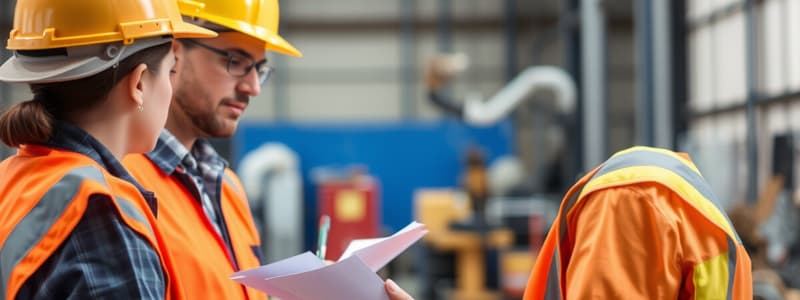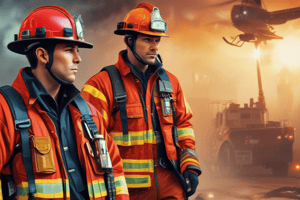Podcast
Questions and Answers
What was the result of the air cylinder explosion on the lifeboat?
What was the result of the air cylinder explosion on the lifeboat?
- The installation was deemed unsafe for personnel.
- Injuries were reported among the crew.
- Significant damage was observed on the lifeboat. (correct)
- The explosion was immediately reported to authorities.
What key factor contributed to the investigation of the air cylinder explosion?
What key factor contributed to the investigation of the air cylinder explosion?
- The installation had been shut-in and uncrewed. (correct)
- Witnesses provided detailed accounts of the incident.
- Regular maintenance was conducted prior to the incident.
- Weather conditions were reported to be severe.
What did the operator do following the incident with the lifeboat?
What did the operator do following the incident with the lifeboat?
- Conducted a complete overhaul of the lifeboat.
- Submitted an incident report without further investigation.
- Coordinated with the servicing vendor and authorities. (correct)
- Closed the installation permanently.
What happened to one of the air bottles during the explosion?
What happened to one of the air bottles during the explosion?
How was the damage from the air cylinder explosion discovered?
How was the damage from the air cylinder explosion discovered?
Flashcards are hidden until you start studying
Study Notes
Lifeboat Air Cylinder Explosion
- An air cylinder explosion occurred on a lifeboat during a periodic inspection of an uncrewed offshore platform.
- Significant damage resulted, with one bottle propelling upwards and embedding in the lifeboat's overhead.
- Corrosion was found on the bottles where they contacted the boat's bottom, exacerbated by poor installation contributing to moisture retention.
- Bottles, purchased in 2018, were installed in a manner that did not allow for proper drainage, raising concerns for similar installations.
Lessons Learned and Recommendations
- Recommendations include bleeding the system after platform shut-in to prevent pressure build-up.
- Emphasization on the purpose and application of the Management of Change (MoC) process.
- Importance of continuous questioning of safety processes and risk assessments is highlighted.
- Better communication among all relevant parties is necessary prior to delivery to ensure proper understanding of safety measures.
Incident Involving Parted Tag Line
- A tagline parted due to excess tension while recovering a LiDAR buoy weighing 2.4 tonnes, leading to uncontrolled buoy movement.
- A worker positioned on deck was struck by the buoy, though no injury occurred.
- Investigation revealed lack of proper planning, supervision, and training; no documented recovery process and non-compliance with lift procedures were also noted.
Lessons Learned and Actions Taken
- Lift activities require thorough planning and documentation of risks, emphasizing effective communication during Toolbox Talks.
- Lift supervisors are advised to remain focused on overseeing tasks rather than performing them.
- Training for relevant crew has been improved to comply with safety and regulatory requirements.
Fall Incident from Step Ladder
- A worker sustained an injury after falling from a 2-step ladder due to the vessel's pitching in rough seas, resulting in a fractured rib.
- The height of the tool access point was 1.6m, and the step ladder was 0.5m high, complicating safe access during adverse conditions.
- At the time of the incident, the deck was wet, and significant wave height was 2m.
General Safety Recommendations
- Emphasize the importance of following Life Saving Rules, particularly avoiding complacency and maintaining risk assessments.
- Workers should actively assess their positioning in relation to loads and identify safe exit routes before lifting operations commence.
Studying That Suits You
Use AI to generate personalized quizzes and flashcards to suit your learning preferences.




